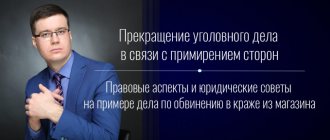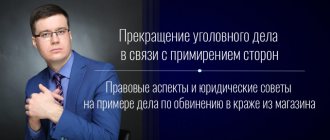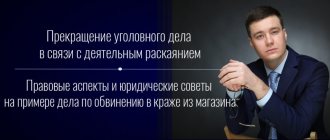Lawyer Spiridonov M.V. 08/17/2017 2 Comments
Law practice of Spiridonov M.V., Criminal cases
lawyer in Novosibirsk, lawyer in cases of necessary defense, lawyer in criminal cases, lie detector, necessary defense, polygraph, exceeding the necessary defense, limits of necessary defense, termination of a criminal case, causing harm in a state of necessary defense, psychological and psychiatric examination, situational examination , art. 112 of the Criminal Code of the Russian Federation, Art. 37 Criminal Code of the Russian Federation
In this article, using the example of a specific case under paragraph “h” of Part 2 of Art. 112 of the Criminal Code of the Russian Federation considers the issue of proving the necessary defense through the use of various methods of defense (polygraph, psychological and psychiatric examination, medical-forensic (situational) forensic examination, lawyer surveys and requests). This case was discontinued at the investigation stage without going to court for consideration on the merits. Yes, it was terminated on a non-rehabilitating basis - in connection with the reconciliation of the parties, but this basis was chosen as a compromise option that suited the principal. The will of the principal is law for the lawyer.
Case plot:
My future client (let's call him Ivan) was driving his car to work. Along the way, he was cut off by another car, creating an emergency situation. Next, the driver of the specified car began to behave aggressively on the road, pulled alongside Ivan’s car, began to shout and demand that he stop, because this man wanted to talk to him. Ivan did not react to the man’s demands and continued to move in his row (at that time on the far right).
At the intersection, Ivan stopped because the traffic light turned red. At that moment, the man who had cut off Ivan drove forward and blocked my client’s path with his car. Having stopped, the man got out of his car and walked towards Ivan’s car.
The client was driving and did not get out of the car. Approaching the car, the man opened the driver's door, Ivan began to get up, tried to get out of the car, and at that moment received a blow from the man in the jaw area. The blow was so strong that after it was delivered, Ivan hit the back of his head on the car body near the roof. After the blow he received, Ivan’s perception was scattered, everything went dark in his eyes, he bent over half-crouched, leaning on the car door, as he felt dizzy. The man who struck the blow shouted phrases about physical violence at Ivan.
Ivan was greatly frightened by the actions of the said man, felt a danger to his life and health, and realized that the attacks on him would continue. The door of his car was open.
Ivan grabbed a knife from the door pocket, as it was the first one that came to his hand.
He grabbed the knife with his left hand, although he was right-handed, he did not plan to strike with a knife, but took out the knife in order to demonstrate to the attacking man so that he would stop striking and calm down.
The man grabbed Ivan by the clothes in the chest area with both hands, from this Ivan began to lose his balance and realized that at that moment the man intended to strike him again in the head. Trying to maintain his balance, Ivan wrapped his arms around the man’s shoulders. Since he had a knife in his left hand, as a result of grasping the man from behind, he accidentally cut him. At the same time, he didn’t even immediately feel or understand that he had caused a cut to the man. After that, the man let go of Ivan and ran towards his car. An ambulance and police officers then arrived at the scene.
Based on the results of the forensic medical examination, it was established that the man suffered moderate harm to health as a result of the cut based on the duration of the health disorder (treatment over 21 days).
Based on this fact, a criminal case was initiated against Ivan under paragraph “z” of Part 2 of Art. 112 of the Criminal Code of the Russian Federation - intentional infliction of moderate harm to health, with the use of a weapon, after which the latter acquired the status of a suspect.
Features of conducting a forensic medical examination
The severity of the damage caused to the victim’s health is established in medical organizations that are part of the health care system, by a doctor with the specialty of a forensic medical expert. One of the listed qualifying signs is sufficient for the degree of harm to be determined. If there are several signs from different groups, then the degree for which more signs were identified than in others is indicated.
In the process of carrying out a forensic medical examination, the object is a living person or a corpse (parts of a corpse), medical documentation and materials on the case, provided in the required order. A prerequisite for a forensic medical examination is the authenticity of documents that reflect a sufficient amount of data about the damage to the victim’s body, the nature of the injuries, and its clinical course. If the data is insufficient, the expert draws up a petition in which he indicates the need for additional information.
Victim's version:
The victim did not agree with the circumstances of the incident as stated by the suspect. The victim indicated that when he approached the car, Ivan got out of it, he began to talk to him, during the conversation the victim approached Ivan, after which they grabbed each other’s clothes, pushed, struggled, moved around, then the victim felt pain in the back area, and in response he punched Ivan in the face. Moving away from Ivan, the victim saw that he had a cut in the neck area. The victim indicated that he did not strike Ivan first; he struck only after Ivan cut him with a knife.
Defense tactics and techniques:
Version No. 1.
Ivan’s actions contain the necessary defense. Even if Ivan’s actions are assessed from the point of view of exceeding the limits of necessary defense, then in any case there is no corpus delicti, since according to paragraph. 3 clause 11 of the Resolution of the Plenum of the Armed Forces of the Russian Federation dated September 27, 2012 No. 19 “On the application by courts of legislation on necessary defense and infliction of harm when detaining a person who has committed a crime” - the intentional infliction of moderate or minor harm to health or beating on an offender does not entail criminal liability , as well as causing any harm through negligence, if this was a consequence of the actions of the person defending himself when repelling a socially dangerous attack.
Accordingly, current legislation does not provide for criminal liability for causing harm to health of moderate severity when the limits of necessary defense are exceeded.
Version No. 2.
The damage inflicted on the man was caused by Ivan through negligence. This event happened by accident when Ivan, trying to maintain his balance, grabbed the man around the shoulders.
Both voiced versions had the right to exist and had to be worked out during the defense.
What are the differences between other degrees of severity?
The above signs are qualifying. They clearly distinguish between moderate harm and severe and mild impairment of the injured person’s body. A mild degree is indicated by a short-term health disorder (no more than 21 days). A severe degree of damage to health is established if the following pathological conditions are present:
- Harm that is life-threatening.
- Terminated pregnancy.
- Loss of hearing, vision or speech or a human organ, as well as loss of function of a particular organ.
- Mental disorder.
- Acquired drug addiction or substance abuse.
- Facial disfigurement that cannot be corrected.
- Lost total ability to work by one third or more.
- Lost completely professional ability to work.
To prove these versions, the defense chose the following tactics:
Establishment of individual psychological characteristics of personality and physical data.
From Ivan’s testimony it followed:
“that he was struck in the head. From this blow, Ivan hit the back of his head on the car body near the roof. After the blow he received, his perception was scattered, everything went dark in his eyes, he was in a state of prostration.”
Further, as part of the lawyer's survey, the following were interviewed: Ivan's wife, his former boss and current boss.
Ivan’s wife explained:
“that her husband is a calm, not hot-tempered person, reasonable by nature, avoids conflicts.”
From the explanations of Ivan’s former boss it follows:
“He knows Ivan as a kind, sympathetic, non-conflict person. He never saw Ivan in an angry, malicious state.”
From the explanations of the current boss, Ivan, it followed:
“Ivan is a very calm, balanced person; he does not tend to conflict, humiliate, or laugh at anyone. Ivan always thinks about his actions for the future, before doing anything, he thinks many times about the possible consequences, and makes sure that his decision is correct.”
By occupation, Ivan was a programmer. According to medical documents included in the case file, Ivan had a number of chronic diseases that did not allow him to be in good physical shape. Ivan’s physique is thin; Ivan has never been involved in combat sports or martial arts.
Through a lawyer's request, it was established that the man who struck Ivan had a military education. According to anthropometric data, he was taller than Ivan and larger in build, weight, and build.
Thanks to the establishment of the individual psychological characteristics of Ivan’s personality and physical data, comparing them with the anthropometric data of the man who hit him, taking into account his military education and special training, it was possible to conclude that in the situation that occurred, Ivan could hardly initiate a conflict with the person who is physically much stronger and older than him.
Application for a forensic psychological and psychiatric examination.
The reason for prescribing a forensic psychological and psychiatric examination is the behavior of the suspect/accused when committing the incriminated act: unexpectedness of actions, the appearance of previously unusual forms of behavior, as well as data on the conflict situation before the event.
The purpose of the examination is to establish in the suspect/accused the presence or absence of a temporary mental disorder (the competence of a psychiatrist-expert), physiological affect (a normal, but extremely strong emotional reaction) or other emotional states (the competence of a psychological expert) at the time of the commission of the incriminated act.
In order to establish these circumstances in relation to Ivan, it became necessary to conduct a comprehensive outpatient psychological and psychiatric examination in order to obtain answers to the following questions:
Was Ivan in a state of passion at the time of committing the act accused of him?
What is Ivan’s general psychological characteristics (temperament, character, inclinations, needs)?
What are Ivan’s individual psychological characteristics (characterological, emotional-volitional)? Did they have a significant influence on his behavior during the commission of the act charged with him?
Was Ivan, at the time of committing the act accused of him, in a state of heightened emotional tension caused by a traumatic situation?
Considering Ivan’s mental state, his individual psychological characteristics, as well as the circumstances of the case, could he accurately correlate his defensive actions with the objective requirements of the situation?
Conducting a psychophysiological study (polygraph test), filing a request for questioning of a polygraph examiner.
The use of a polygraph (lie detector) in the process of evidence in criminal cases is highly controversial. As a general rule, the conclusion based on the results of a polygraph test is not accepted as evidence in a criminal case, however, the opposite practice also exists. At the same time, one of the ways to legalize a polygraph conclusion is to interrogate the person who conducted the specified study as a specialist. In combination with a polygraph conclusion and an interrogation of a polygraph examiner, the chances that this conclusion will be taken into account increase. In addition, it is worth considering that even if the polygraph report is not regarded as evidence in the case, in any case it contains indicative information that may be valuable in the absence of other evidence.
In the case under consideration, the use of a polygraph was due to the fact that Ivan’s testimony and the testimony of the man who was injured were significantly different, and there was no other evidence with which to eliminate the contradictions.
As a result of the psychophysiological study, it was found that Ivan’s reactions to the questions asked were consistent with his answers about the events of bodily harm. Thus, it was established that Ivan’s testimony regarding the circumstances of the event was truthful. The conclusion of the psychophysiological study was added to the materials of the criminal case.
In order to establish the circumstances of the psychophysiological study, clarify the methods, equipment used by the specialist, the validity of the study and the conclusion reached, a request was made to interrogate the person who conducted the study as a specialist. In addition, a request was made to conduct a psychophysiological examination of the victim in order to establish the veracity of his testimony.
Application for a medical-forensic (situational) forensic examination.
During the investigation of the criminal case, two versions of the event were identified in terms of causing damage (the suspect's version and the victim's version). The versions presented by the suspect and the victim had contradictions in the following points:
The victim claimed that Ivan struck him first, only after that the victim hit Ivan in the face area. Ivan sets out a different sequence, and indicates that the infliction of damage with a knife occurred after a blow to his face, while the infliction of damage with a knife was unintentional, and became possible only as a result of the fact that the victim grabbed him with his hands in the chest area and tried to maintain balance Ivan grabbed the victim’s shoulders, thereby accidentally cutting his body in the neck area.
The victim claims that when he and Ivan took hold of the clothes, they moved around. Ivan claims that he did not grab the victim’s clothes and they stood still.
The victim claims that when he and Ivan grabbed each other’s clothes, they pushed each other and tried to throw each other to the ground. Ivan indicates that these actions did not occur, that he did not push or try to throw the victim to the ground.
Considering that the mechanism of formation of the injuries present to the victim is essential for the investigation of a criminal case, taking into account that the version presented by the suspect must be verified, the need arose to conduct a medical-forensic (situational) forensic examination, during which, with the participation of It is possible for a forensic physician to recreate the situation of the event and check the possibility of causing damage to the victim based on the version stated by the suspect, namely, to obtain answers to the following questions:
What is the mechanism of formation and localization of the injuries the victim has?
Could the injuries present to the victim have occurred under the circumstances stated by the suspect?
What is the mechanism of formation and localization of the damage present on the suspect?
Could the suspect’s injuries (contusion of the soft tissues of the face on the left in the projection of the cheekbone and bruise of the soft tissues of the occipital part of the head) occur under the circumstances described by the suspect?





